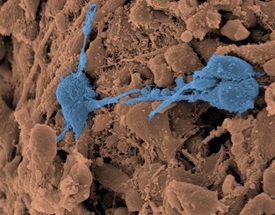February 18, 2019


Researchers at The University of Kansas Cancer Center have developed a first-of-its-kind organoid that mirrors the process of cancer spreading to the lung. Called a tumor-in-a-dish, the model gives researchers insight on what goes on inside a tumor and the drugs that may best kill it. Their findings were published in Cancer Research.
Cancer that spreads, or metastasizes, to the lungs is sometimes called secondary cancer. The primary cancer is the original site – such as the breast or colon – where the cancer began. Secondary lung cancer occurs in 30 to 55 percent of advanced cancers. Despite the high rate of lung metastasis, few such research models exist.
“There is a dearth of models to study how cancer cells metastasize, especially after they move out of their primary site,” said Shrikant Anant, PhD, lead author and chair of Cancer Biology. “To address this gap, we developed a novel lung organoid in a dish that helps demonstrate the ability of cancer cells of various origins to spread to the lung.”
The metastatic tumor-in-a-dish replicates the lung microenvironment with air sac-like structures. Once colonized with cancer cells, the team can test drugs to determine what effectively kills the tumor cells, as well as observe the biology of tumor colonization.

According to study contributor Prabhu Ramamoorthy, PhD, the model could be a promising tool in precision medicine. “We could grow a patient’s cells in this dish and, with molecular profiling, identify the ideal therapies based on the cells response,” Dr. Ramamoorthy said. “Each treatment would be tailored based on what we find in the dish.”